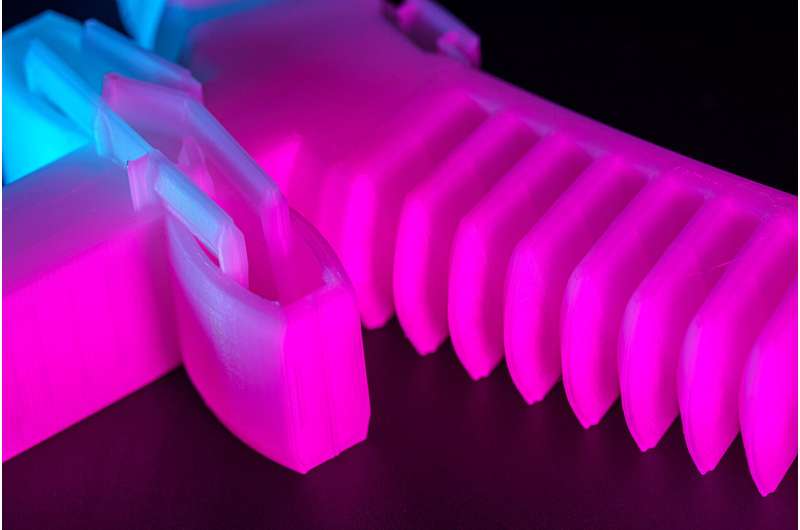This article has been reviewed according to Science X's editorial process and policies. Editors have highlighted the following attributes while ensuring the content's credibility:
fact-checked
peer-reviewed publication
trusted source
proofread
3D printed robotic gripper doesn't need electronics to function

A new soft robotic gripper is not only 3D printed in one print, it also doesn't need any electronics to work. The device was developed by a team of roboticists at the University of California San Diego, in collaboration with researchers at the BASF corporation, who detailed their work in Science Robotics.
The researchers wanted to design a soft gripper that would be ready to use right as it comes off the 3D printer, equipped with built in gravity and touch sensors. As a result, the gripper can pick up, hold, and release objects. No such gripper existed before this work.
"We designed functions so that a series of valves would allow the gripper to both grip on contact and release at the right time," said Yichen Zhai, a postdoctoral researcher in the Bioinspired Robotics and Design Lab at the University of California San Diego and the leading author of the paper. "It's the first time such a gripper can both grip and release. All you have to do is turn the gripper horizontally. This triggers a change in the airflow in the valves, making the two fingers of the gripper release."
This fluidic logic allows the robot to remember when it has grasped an object and is holding on to it. When it detects the weight of the object pushing to the side, as it is rotating to the horizontal, it releases the object.
Soft robotics holds the promise of allowing robots to interact safely with humans and delicate objects. This gripper can be mounted on a robotic arm for industrial manufacturing applications, food production and the handling of fruits and vegetables. It can also be mounted onto a robot for research and exploration tasks. In addition, it can function untethered, with a bottle of high-pressure gas as its only power source.
Most 3D-printed soft robots often have a certain degree of stiffness; contain a large number of leaks when they come off the printer; and need a fair amount of processing and assembly after printing in order to be usable.
The team overcame these obstacles by developing a new 3D printing method, which involves the printer nozzle tracing a continuous path through the entire pattern of each layer printed.
"It's like drawing a picture without ever lifting the pencil off the page," said Michael T. Tolley, the senior author on the paper and an associate professor in the UC San Diego Jacobs School of Engineering.
This method reduces the likelihood of leaks and defects in the printed piece, which are very common when printing with soft materials.
The new method also allows for printing of thin walls, down to 0.5 millimeters in thickness. The thinner walls and complex, curved shapes allow for a higher range of deformation, resulting in a softer structure overall. Researchers based the method on the Eulerian path, which in graph theory is a trail in a graph that touches every edge of that graph once and once only.
"When we followed these rules, we were able to consistently print functional pneumatic soft robots with embedded control circuits," said Tolley.
More information: Yichen Zhai et al, Desktop fabrication of monolithic soft robotic devices with embedded fluidic control circuits, Science Robotics (2023). DOI: 10.1126/scirobotics.adg3792


















